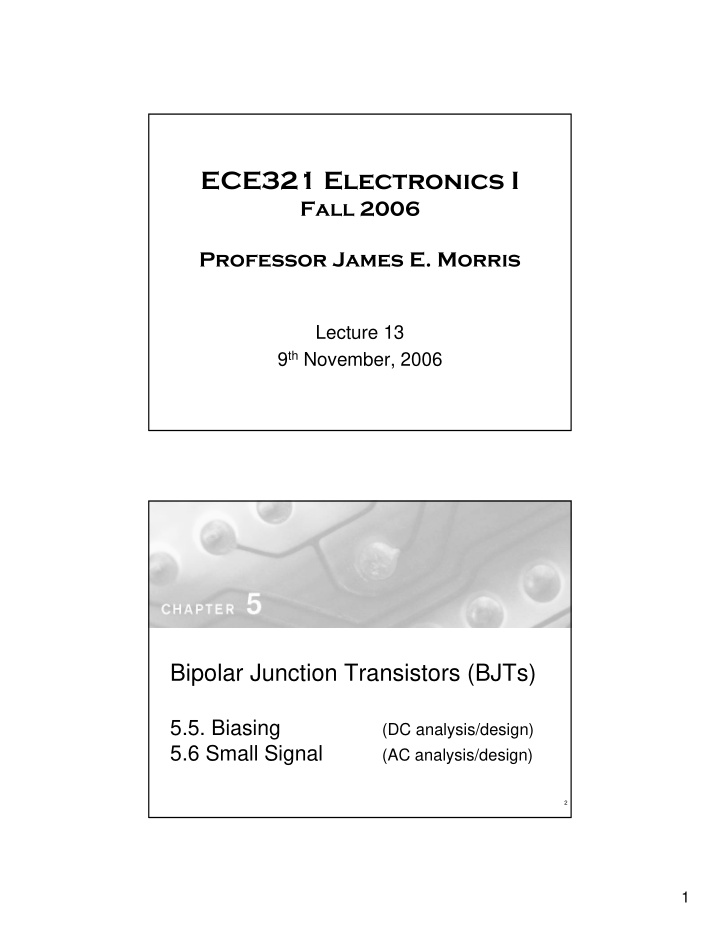



ECE321 Electronics I Fall 2006 Professor James E. Morris Lecture 13 9 th November, 2006 Bipolar Junction Transistors (BJTs) 5.5. Biasing (DC analysis/design) 5.6 Small Signal (AC analysis/design) 2 1
Figure 5.43 Two obvious schemes for biasing the BJT: (a) by fixing V BE ; (b) by fixing I B . Both result in wide variations in I C and hence in V CE and therefore are considered to be “bad.” Neither scheme is recommended. Figure 5.44 Classical biasing for BJTs using a single power supply: (a) circuit; (b) circuit with the voltage divider supplying the base replaced with its Thévenin equivalent. 2
Figure 5.45 Biasing the BJT using two power supplies. Resistor R B is needed only if the signal is to be capacitively coupled to the base. Otherwise, the base can be connected directly to ground, or to a grounded signal source, resulting in almost total β -independence of the bias current. Figure 5.46 (a) A common-emitter transistor amplifier biased by a feedback resistor R B . (b) Analysis of the circuit in (a). 3
Figure 5.47 (a) A BJT biased using a constant-current source I . (b) Circuit for implementing the current source I . Figure 5.48 (a) Conceptual circuit to illustrate the operation of the transistor as an amplifier. (b) The circuit of (a) with the signal source v be eliminated for dc (bias) analysis. 4
Figure 5.49 Linear operation of the transistor under the small-signal condition: A small signal v be with a triangular waveform is superimposed on the dc voltage V BE . It gives rise to a collector signal current i c , also of triangular waveform, superimposed on the dc current I C . Here, i c = g m v be , where g m is the slope of the i C – v BE curve at the bias point Q . Figure 5.50 The amplifier circuit of Fig. 5.48(a) with the dc sources ( V BE and V CC ) eliminated (short circuited). Thus only the signal components are present. Note that this is a representation of the signal operation of the BJT and not an actual amplifier circuit. 5
Figure 5.51 Two slightly different versions of the simplified hybrid- π model for the small-signal operation of the BJT. The equivalent circuit in (a) represents the BJT as a voltage-controlled current source (a transconductance amplifier), and that in (b) represents the BJT as a current- controlled current source (a current amplifier). Figure 5.52 Two slightly different versions of what is known as the T model of the BJT. The circuit in (a) is a voltage-controlled current source representation and that in (b) is a current-controlled current source representation. These models explicitly show the emitter resistance r e rather than the base resistance r π featured in the hybrid- π model. 6
Figure 5.53 Example 5.14: (a) circuit; (b) dc analysis; (c) small-signal model. Figure 5.54 Signal waveforms in the circuit of Fig. 5.53. 7
Figure 5.55 Example 5.16: (a) circuit; (b) dc analysis; (c) small-signal model; (d) small-signal analysis performed directly on the circuit. Figure 5.56 Distortion in output signal due to transistor cutoff. Note that it is assumed that no distortion due to the transistor nonlinear characteristics is occurring. 8
Figure 5.57 Input and output waveforms for the circuit of Fig. 5.55. Observe that this amplifier is noninverting, a property of the common-base configuration. Figure 5.58 The hybrid- π small-signal model, in its two versions, with the resistance r o included. 9
Figure E5.40 Table 5.4 10
Recommend
More recommend